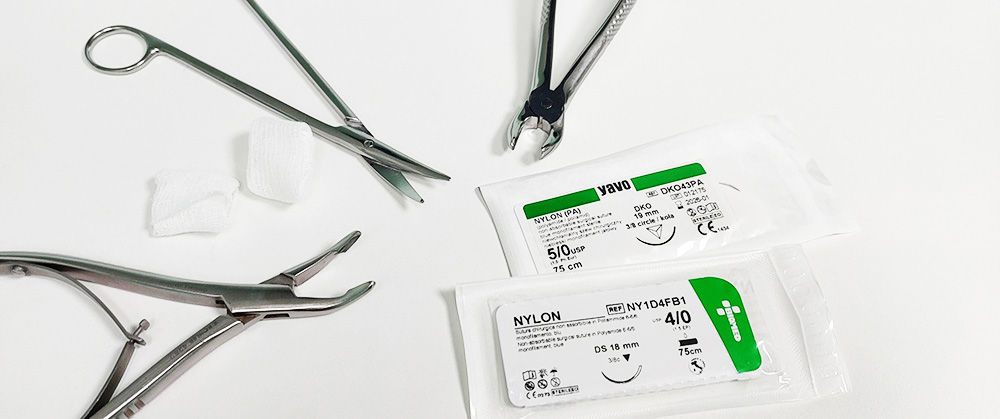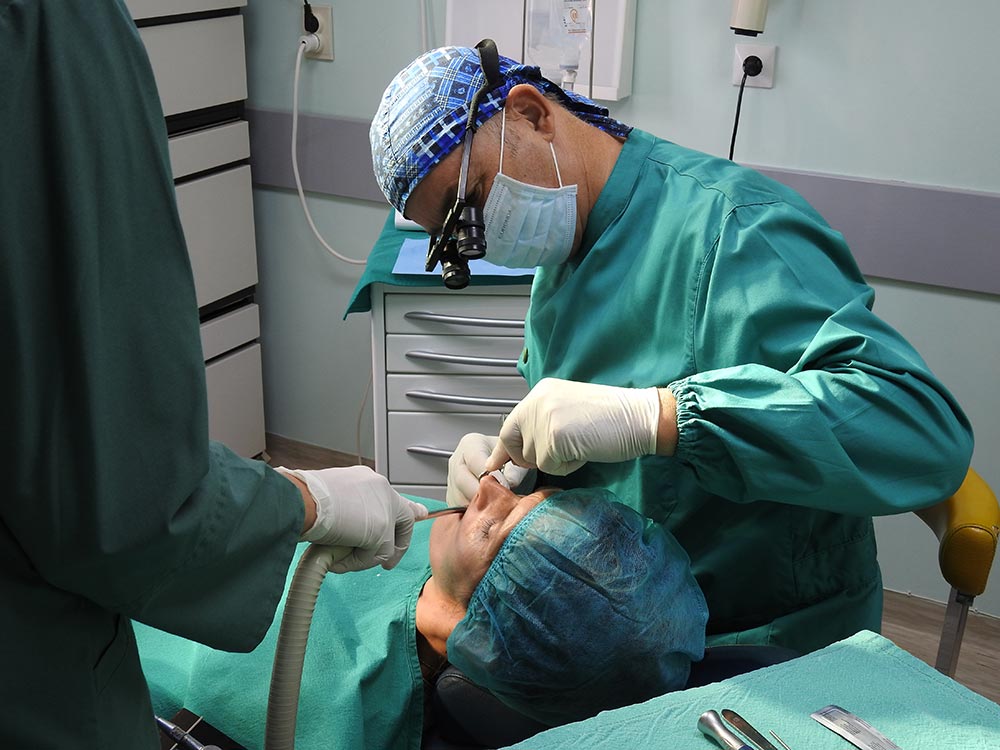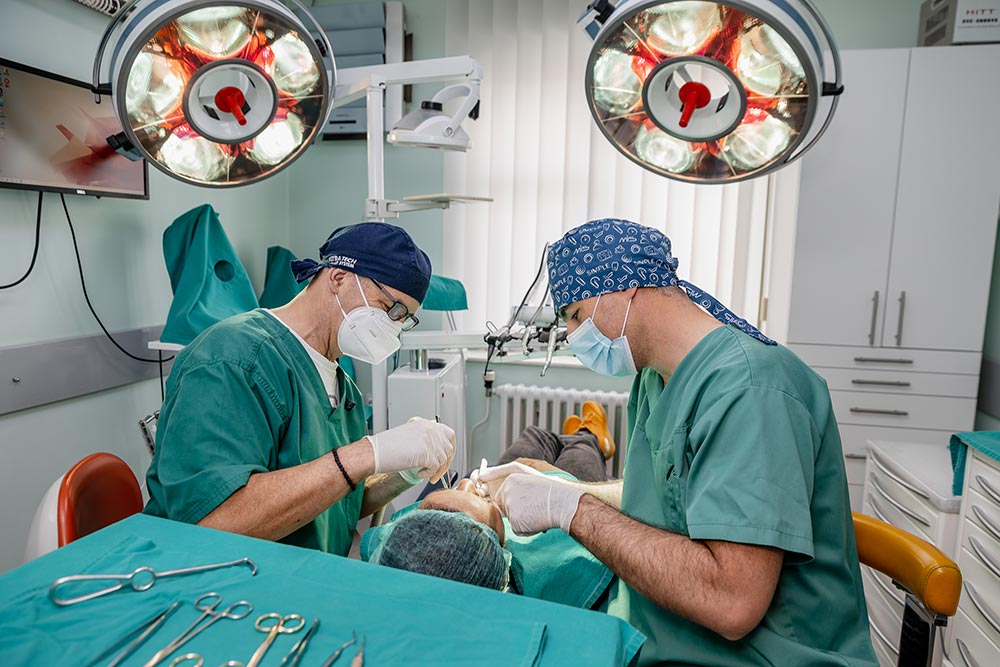Oral surgery
Oral surgery is a dental discipline that includes all interventions on teeth, alveolar tissue, bones of the upper and lower jaw, as well as the surrounding oral and facial structures.
This branch of surgery includes a series of operations whose purpose is to improve the unfavorable anatomical and biological conditions of the dentofacial region.
With the application of today’s modern methods, oral surgery does not cause fear in patients as it used to. Intraoperative pain does not exist or is reduced to a minimum, and drug therapy perfectly controls possible painful postoperative symptoms.
Oral surgery - Interventions
The procedures that are most often performed in oral surgery are:
- tooth extraction;
- surgical extraction of wisdom teeth, impacted teeth and residual tooth roots;
- apicoectomy (resection of the tooth root);
- cyst surgery (cystectomy);
- jawbone augmentation (regeneration);
- sinus lift;
- dental implants, etc.
All the aforementioned interventions are conducted under local anesthesia.
The collaborative efforts of the Dental Clinic Dr. Veselinović team encompass a high level of cooperation between our oral surgeons and orthodontists for orthodontic surgery, as well as with prosthetists for pre-prosthetic surgery.

The goal of the Dental Clinic Dr. Veselinović is above all the safety and quality of the services provided to the patient. A team of top experts, and constant investment in the quality and education of staff, make us one of the most competent clinics for oral surgery and implantology in our region.
Tooth extraction (extraction)
Tooth extraction is a dental procedure that causes the most fear among patients. However, dentists will always do their best to avoid tooth extraction. Unfortunately, this is sometimes not possible.
The need for extraction occurs when a tooth is affected by deep caries, which has destroyed most of the tooth, and it is no longer possible to “save it”. In such cases, our dentists approach tooth extraction using modern methods. So, fast, painless, and efficient.
However, tooth extraction is not a decision that is made in advance: it is preceded by an examination and X-ray imaging of the teeth.
Basic, complicated, and surgical tooth extractions are performed at our clinic. All three interventions are routine procedures for our team of dentists, i.e. oral surgeons. They are performed under local anesthesia, which makes them painless for the patient.
If it is about the extraction of baby teeth, a surface anesthetic is usually applied in the form of a spray or gel, while in adult patients anesthesia is injected with a syringe.
Basic tooth extraction
Basic tooth extraction is applied to teeth with a preserved crown and visible in the jaws. After loosening the tooth with a dental lever, extraction is started with pliers. The procedure is not painful and the patient can immediately resume his daily activities after a simple tooth extraction. However, it is necessary to avoid greater physical efforts and exposure to the sun.
Postoperatively, it is advised to keep gauze between the teeth for 1-2 hours to stop the bleeding. It is advisable to apply cold compresses on the outside of the cheek in order to stop the bleeding and prevent possible swelling. It is also advised not to rinse the mouth for 1-2 hours after extraction.
The teeth should be washed normally, the only thing to be avoided is the area where the tooth was extracted. Also, the patient can eat normally when the anesthesia wears off.
Surgical extraction of wisdom teeth, impacted teeth and residual tooth roots
Complicated tooth extraction is reserved for destroyed teeth in which the crown is fractured or mostly destroyed by caries. This type of extraction is also applicable for teeth in which the root was left during the previous extraction or during the traumatic eruption of the tooth from the cup.
Impacted teeth are surgically removed. Impacted teeth are non-erupted teeth, those that remained “trapped” in the jaw even though the time for their sprouting has long passed. This usually happens in narrow jaws where there is not enough room, that is, where anxiety reigns.
Such teeth grow at different angles (crooked). And, they can be directed towards the adjacent tooth (affecting its position) or turned outwards, towards the edge of the jaw.
Teeth can be fully or partially impacted (semi-impacted). In most patients, the upper and lower wisdom teeth are usually impacted, but also the upper incisors and canines, as well as the lower premolars.

Oral surgery and apicotomy
Apicoectomy or tooth root resection is an oral surgical procedure that is used in the case of an infected tooth root (apex), i.e. the existence of a periapical lesion (process, granuloma) on it. The granuloma removal procedure is used when endodontic therapy of dental canals has not yielded results.
Apicoectomy, i.e. by removing the tip of the root and the surrounding tissue affected by the infection, the tooth that would otherwise have to be extracted is saved. After this procedure, the filling of the root canal and its hermetic closure follows.
Augmentation (regeneration) of bone
If the bone is not of sufficient size to place the implant, it is necessary to proceed with augmentation, i.e. bone building. This is done by transplanting bone from the patient’s body (autotransplant) and/or using artificial bone. This surgical procedure is performed if there is no required width or height of the jawbone.
It is possible to perform the procedure in both jaws if there are minimal bases of the patient’s bone. Depending on the situation, sometimes the implants are placed at the same time as the augmentation. In more severe cases, bone augmentation is necessary first, and the installation of implants follows only after the necessary healing time.
With the incredibly fast development of implantology, today it is possible to perform procedures like this, which until recently could only be dreamed of.
Raising the sinus floor (sinus-lift)
Maxillary sinus floor augmentation (sinus-lift) is a surgical procedure that provides a place for the bone superstructure that is missing in the lateral part of the upper jaw. Lack of jawbone is a frequent consequence of long-term lack of teeth and the absence of appropriate therapy.
Sometimes the dental implants are placed simultaneously with the sinus-lift. In more severe cases, it is necessary to perform the procedure first and place the implants only after the necessary healing time. Sinus-lift is performed under local anesthesia, which makes this procedure painless. Our oral surgeon has knowledge and skills about the various techniques used during this intervention.
Surgical release of impacted teeth for orthodontic purposes
Surgical release of impacted teeth for orthodontic purposes typically involves the release of teeth that are already present as defects in the jawbone (either in the lower or upper jaw) but, for some (un)known reasons, have failed to grow at the occlusal level.
In the upper jaw, this most commonly concerns canines, which may be positioned palatally (toward the palate) or buccally (toward the cheek).
Another issue, resulting from trauma to the baby teeth, is a disruption in the growth of the upper incisors. Permanent incisors remain trapped in the jawbone, unable to develop normally in a timely manner.
In the lower jaw, the most common need is the extraction of the first or second premolars.
Preprosthetic surgery
Preprosthetic surgery involves preparing the bone structures and soft tissues for the fabrication of prosthetic replacements. These interventions include:
- Removal of hypertrophic soft tissue;
- Plastia of the ridge and frenulum;
- Alveolar ridge leveling;
- Clinical crown extension;
- Vestibuloplasty;
Oral surgery and installation of implants
Dental implants are titanium or zirconium screws placed in the jaw as a replacement for the root of a missing natural tooth. Dental implant surgery is painless and is performed under local anesthesia.
Implantology is a field in which we have enviable experience. Dental implants are installed at Dental Clinic Dr. Veselinović with great safety and excellent results.
Before surgery, it is necessary to take an x-ray of the jaw, which patients can do in the x-rayroom within the clinic. After a specialist examination by our oral surgeons and implantologists, a decision is made on the best type of therapy for partial or complete toothlessness. The type of implant to be used depends on the condition of the bone and the special wishes of the patient, and we only use the best quality ones.
With the help of dental implants, the problem of missing one or more teeth no longer exists. The lack of all teeth can also be solved with implants that take over the role of the support and replace the root of the tooth.
If the patient follows the instructions for maintaining oral hygiene and regularly visits the dentist, dental implants can last a lifetime.

Surgery of jaw and other oral cysts
Cystectomy or jaw cyst (and other other cysts of the oral cavity) removal surgery belongs to the domain of interventions that are also performed by our oral surgeons.
Cysts are pathological, soft tissue lesions filled with mucous fluid. They can occur on the jawbone or on the soft tissue of the oral cavity (the inside of the lips or cheeks). The causes of their occurrence are manifold: chronic tooth infections, cellular remnants of tissue from which teeth develop, pathological development of tissue that is not related to teeth, etc.
Cysts require surgical excision. Since they show a tendency to grow, they can destroy the surrounding bone tissue if they are not removed. After the surgical removal of the cyst (which is usually followed by an apicotomy), the tooth can perform its function for a long time. Such a tooth becomes a part of prosthetic rehabilitation, that is, it serves as a bridge support.
